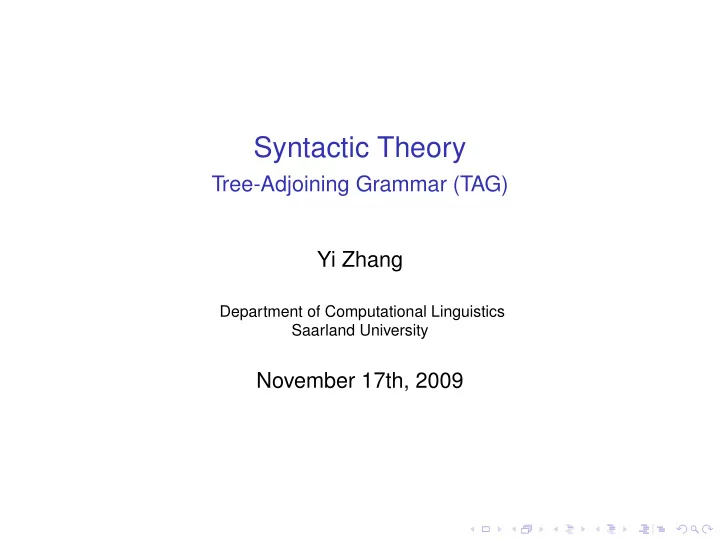

Syntactic Theory Tree-Adjoining Grammar (TAG) Yi Zhang Department of Computational Linguistics Saarland University November 17th, 2009
Outline XTAG: A Lexicalized Tree Adjoining Grammar for English NLP with Tree-Adjoining Grammars
The XTAG Project ◮ A long-term project to develop a wide-coverage grammar for English using the Lexicalized Tree-Adjoining Grammar (LTAG) formalism ◮ Provides a grammar engineering platform consisting of a parser, a grammar development interface, and a morphological analyzer ◮ The project extends to variants of the formalism, and languages other than English
Overview of the XTAG System
Components in the XTAG System ◮ Morphological Analyzer & Morph DB: 317K inflected items derived from over 90K stems ◮ POS Tagger & Lex Prob DB: Wall Street Journal-trained 3-gram tagger with N -best POS sequences ◮ Syntactic DB: over 30K entries, each consisting of: ◮ Uninflected form of the word ◮ POS ◮ List of trees or tree-families associated with the word ◮ List of feature equations ◮ Tree DB: 1004 trees, divided into 53 tree families and 221 individual trees
Overview of the Grammar Design ◮ Tree family: a set of elementary trees for predicative words to represent the linguistic notion of subcategorization ◮ Complements & Adjuncts ◮ Complements are included in the elementary tree anchored by the word that selects them ◮ Adjuncts do not originate in the same elementary tree as the head word; they are added to a structure by adjunction ◮ Non-S constituent trees does not group into families ◮ Nouns carry case with them, which is checked against the verbs by unification
Example Verb Classes Declarative Intransitive Tree Example S r eat, sleep, dance NP 0 ↓ VP ◮ Al ate. ◮ Seth slept. V ⋄ ◮ Hyun danced.
Example Verb Classes Declarative Transitive Tree Example eat, dance, take, like S r ◮ Al ate an apple. ◮ Seth danced the tango. NP 0 ↓ VP ◮ Hyun is taking an V ⋄ NP 1 ↓ algorithms course. ◮ Anoop likes the fact that the semester is finished.
Example Verb Classes Declarative Multiple Anchor Ditransitive with PP Tree Example S r gear for, give to, remind of NP 0 ↓ VP ◮ The attorney geared his client for the trial. ◮ He gave the book to V ⋄ NP 1 VP e his teacher. V eNA PP ◮ The city reminded P ⋄ NP 2 ↓ ǫ v John of his home town.
Example Verb Classes Declarative Intransitive with Adjective Tree Example become, grow, smell S r ◮ The greenhouse became hotter. NP 0 ↓ VP ◮ The plants grew tall and V ⋄ AP 1 ↓ strong. ◮ The flowers smelled wonderful.
Example Verb Classes Declarative NP It-Cleft Tree S r NP 0 VP Example it be N ⋄ V ⋄ VP 1 ◮ It was yesterday that we had the meeting. V 1 NA NP 1 ↓ S 2 ↓ ǫ
Example Verb Classes Declarative Transitive Idiom Tree S r Example kick the bucket, bury the NP 0 ↓ VP hatchet, break the ice ◮ Nixon kicked the bucket. V ⋄ NP 1 ◮ The opponents finally DetP 1 N 1 ⋄ buried the hatchet. ◮ The group activity really D 1 ⋄ broke the ice.
Passives ◮ The subject NP is interpreted as having the same role as the direct object NP in the active declarative S r S r S r NP 1 ↓ VP NP 1 ↓ VP NP 1 ↓ VP V ⋄ S 2 ∗ V ⋄ S 2 ∗ PP V ⋄ PP S 2 ∗ P NP 0 ↓ P NP 0 ↓ by by
Complementizer ◮ mode feature constrains the type of clauses to which the complementizer adjoins ◮ comp and wh feature receives their root node value from the complementizer and ensure no stacked complementizer with comp=nil on the foot node S c Comp S r ∗ NA that (Feature structures on the whiteboard)
Subordinate Clauses ◮ Before the matrix clause S r S 1 NA S f ∗ P S ↓ because
Subordinate Clauses ◮ After the matrix clause VP r VP f ∗ NA PP P 1 S ↓ P N in order
Subordinate Clauses ◮ Before the VP , surrounded by two punctuation marks VP r Punct 1 PP Punct 2 VP ∗ NA P S ↓ P 1 P 2 as if
Subordinate Clauses ◮ After the matrix clause, separated by a punctuation mark S r S f ∗ NA Punct ↓ PP P S ↓ when
Imperatives ◮ An overt subject with second person ◮ Negative imperative is done by adjoining don’t to the root S r S r V S ∗ NA NP 0 NA VP don’t V ⋄ NP 1 ↓ ǫ
Outline XTAG: A Lexicalized Tree Adjoining Grammar for English NLP with Tree-Adjoining Grammars
Parsing Tree-Adjoining Grammar ◮ A CKY-like algorithm runs in O ( n 6 ) time ◮ An Earley-like algorithm (with 4 operations: SCAN , PREDICT , COMPLETE , ADJOIN ) can reduce the average time complexity by top-down prediction
Supertagging ◮ The large number of elementary trees pose a computational challenge ◮ One can view an elementary tree as a supertag , and use statistical models to assign the most likely ( n ) supertag(s) for a given word within particular context ◮ Efficiency can be greatly enhanced without visible loss in parsing accuracy
References I Joshi, A. and Schabes, Y. (1997). Tree-adjoining grammars.
Recommend
More recommend